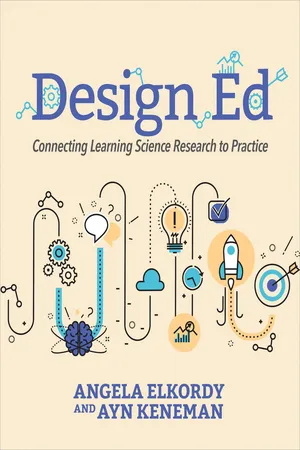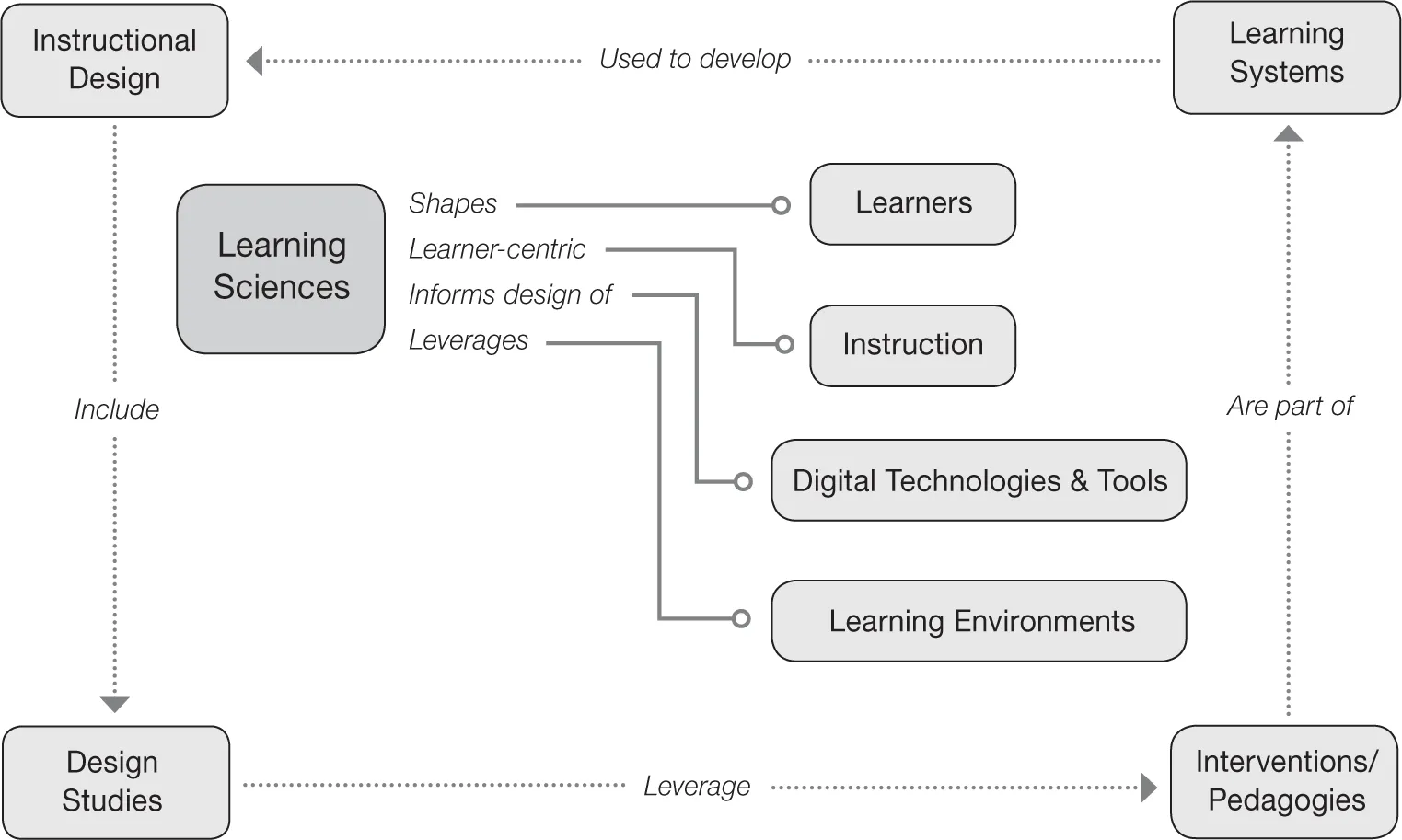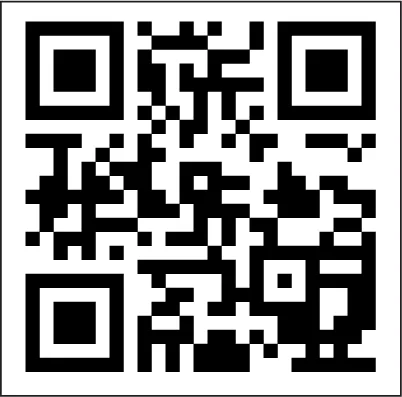
eBook - ePub
Available until 26 Feb |Learn more
Design Ed
Connecting Learning Science Research to Practice
This book is available to read until 26th February, 2026
- English
- ePUB (mobile friendly)
- Available on iOS & Android
eBook - ePub
Available until 26 Feb |Learn more
About this book
Design Ed provides a foundation for the science of learning and shows how to apply design thinking strategies to drive engagement for digital age learners.
Researchers in learning sciences are pioneering instructional technologies that have the capacity to revolutionize the educational system. By combining design thinking methodology with strong theoretical frameworks in the learning sciences, educators can improve learning to help students thrive. This book lays out the intersection between theory, design and reflective practice to help educators understand individual learner differences and the impact of context upon learning. With this foundation, you'll develop the skills you need to design powerful and effective learning experiences, particularly when using digital technologies.
Topics covered include:
Throughout the text, the authors emphasize the "why" behind the use of technology and the "how" to enact learning design for all digital age learners.
Audience: K-12 educators, curriculum specialists
Researchers in learning sciences are pioneering instructional technologies that have the capacity to revolutionize the educational system. By combining design thinking methodology with strong theoretical frameworks in the learning sciences, educators can improve learning to help students thrive. This book lays out the intersection between theory, design and reflective practice to help educators understand individual learner differences and the impact of context upon learning. With this foundation, you'll develop the skills you need to design powerful and effective learning experiences, particularly when using digital technologies.
Topics covered include:
- Educators as learning designers
- Shaping experiences for digital age learning through digital media and digital environments
- Design and format of educational interventions
- The role of reflective practice and evaluating the impact on student learning
Throughout the text, the authors emphasize the "why" behind the use of technology and the "how" to enact learning design for all digital age learners.
Audience: K-12 educators, curriculum specialists
Frequently asked questions
Yes, you can cancel anytime from the Subscription tab in your account settings on the Perlego website. Your subscription will stay active until the end of your current billing period. Learn how to cancel your subscription.
No, books cannot be downloaded as external files, such as PDFs, for use outside of Perlego. However, you can download books within the Perlego app for offline reading on mobile or tablet. Learn more here.
Perlego offers two plans: Essential and Complete
- Essential is ideal for learners and professionals who enjoy exploring a wide range of subjects. Access the Essential Library with 800,000+ trusted titles and best-sellers across business, personal growth, and the humanities. Includes unlimited reading time and Standard Read Aloud voice.
- Complete: Perfect for advanced learners and researchers needing full, unrestricted access. Unlock 1.4M+ books across hundreds of subjects, including academic and specialized titles. The Complete Plan also includes advanced features like Premium Read Aloud and Research Assistant.
We are an online textbook subscription service, where you can get access to an entire online library for less than the price of a single book per month. With over 1 million books across 1000+ topics, we’ve got you covered! Learn more here.
Look out for the read-aloud symbol on your next book to see if you can listen to it. The read-aloud tool reads text aloud for you, highlighting the text as it is being read. You can pause it, speed it up and slow it down. Learn more here.
Yes! You can use the Perlego app on both iOS or Android devices to read anytime, anywhere — even offline. Perfect for commutes or when you’re on the go.
Please note we cannot support devices running on iOS 13 and Android 7 or earlier. Learn more about using the app.
Please note we cannot support devices running on iOS 13 and Android 7 or earlier. Learn more about using the app.
Yes, you can access Design Ed by Angela Elkordy,Ayn Keneman in PDF and/or ePUB format, as well as other popular books in Education & Education Teaching Methods. We have over one million books available in our catalogue for you to explore.
Information
Topic
EducationSubtopic
Education Teaching MethodsPART I
Lessons from the Field: Learning, Design and Technology

THIS SECTION:
• familiarizes the reader with the field of learning sciences and the role of theories of learning to understand and inform design of digital learning activities and environments
• introduces the unique characteristics of learning in the digital age (including formal and informal contexts)
• identifies and investigates the underlying principles of how learning happens and addresses key questions from a variety of disciplines (for example, cognition and social/emotional factors, human development, and socio-cultural context)
How can we effectively design the instructional environment and digital learning activities in order to make an impact on student learning? How do we know our methods are effective? Educators are increasingly looking at the learning sciences to help them answer these questions. The learning sciences is a rapidly growing field with a recurring theme—theory and practice informing each other in order to design more effective learner outcomes.
Teaching can be considered a design science in that good instruction requires educators to think about learning as a system. Within the systems, there are guiding principles and interactions between learners, the learning content, instructional methods, materials and tools, teacher-facilitators and learner-peers. Through repeated iterations or cycles, analysis of outcomes and modifications to subsequent cycles, the effectiveness of instruction and learner outcomes can be improved.
In Part 1, we introduce the unique characteristics of learners and learning in the digital age in both formal and informal contexts. We discuss the importance of learning theories and contributions from educational research in the learning sciences for impactful teaching practices as well as the purposeful design of learning experiences for targeted learning outcomes. Throughout, we will examine, critique and investigate underlying principles of how learners learn and address key questions from a variety of disciplines and perspectives related to the learning sciences. Our focus is primarily on cognition and social/emotional factors, human development and design for learning in sociocultural contexts.
We will examine the relationships between learners and learning, teachers and teaching as well as learning environments and the digital technologies and tools used for instruction. In analyzing and then applying these concepts, you’ll be developing your practice in line with the vision of the ISTE standards for Coaches, Educational Leaders—and especially, for Educators. In the ISTE framework, Educators are Learners, Designers, Facilitators and Analysts of teaching and learning.
CHAPTER 1

Educators, Learning Design, and the Science of Learning
Teaching is not rocket science; it is much, much harder than that.
—LAURILLARD, 2012, P. 3
Teaching and learning has fundamentally changed in the digital age. Teachers have seen major changes in their roles and the expectations for learners. Digital tools and technologies play a bigger part in education every year. Alongside these changes has been a proliferation of research in the learning sciences that educators can parse, evaluate, and fold into their pedagogy to improve student learning.
In this chapter, we examine how teaching has changed in the digital age, and general concepts of the learning sciences. We introduce the ideas of learning systems, instructional design, and teaching as a design science.
By the end of this chapter, you will be able to:
• Understand the need to study teaching and learning in different systems, and contexts, both formal (such as classroom settings) and informal (such as libraries and museums), in the digital age.
• Explain the development of, and a rationale, for the learning sciences as an interdisciplinary area of study with intertwined bodies of knowledge in several fields.
• Provide a rationale for Communities of Practice (COPs) for professional learning.
• Explain the conceptualization of teaching as a design science.
• Understand design-based research (DBR) educational research methodology.
• Understand the LITE framework as a guide for designing experiences which are informed by findings in the learning sciences.
ISTE Standards Connection
The following standards are addressed in this chapter:
ISTE Standards for Educators
1. Learner. Educators continually improve their practice by learning from and with others and exploring proven and promising practices that leverage technology to improve student learning. Educators:
Learner 1a. Set professional learning goals to explore and apply pedagogical approaches made possible by technology and reflect on their effectiveness.
Learner 1b. Pursue professional interests by creating and actively participating in local and global learning networks.
Learner 1c. Stay current with research that supports improved student learning outcomes, including findings from the learning sciences.
ISTE Standards for Education Leaders
Connected Learner 5a. Leaders set goals to remain current on emerging technologies for learning, innovations in pedagogy and advancements in the learning sciences.
Why am I only learning about the learning sciences in my graduate courses and not as an undergraduate?
—GRADUATE LEARNER, WINTER, 2017
Leading Learning in the Digital Age
The proliferation of information, media, and social communications in the digital age compound the complexity of instructional practice. Not only are the tools and strategies for learning significantly different from the recent past (only 20 years ago!), but also learner outcomes have evolved dramatically. For example, it’s no longer enough for schools to simply teach factual knowledge. Communities, families, and the students themselves now expect schools to help learners develop the skills, knowledge, and dispositions necessary to engage with and be productive in a globally-networked, digitally-mediated environment. These new expectations and outcomes are entirely different from those deemed essential for success in the past. In his book, The Social Neuroscience of Education, professor of psychology Louis Cozolino (2013) describes the mismatch between old-style education and the knowledge and skills needed for today’s workplace:
… most schools are based on a model of industrial production where uniform materials are converted into a predetermined product. This model has proven itself over the last 150 years and works exceptionally well for making automobiles, washing machines, and chicken nuggets. (p. x–vi)
Furthermore, there have been dramatic changes in the way in which knowledge is defined, acquired, conferred and used. Educators are preparing learners for an unknown future where the only certainty seems to be the continuing trajectory of change. The challenges we face as educators are often contextually-bound and complex with increasingly diversity in our learners, who have a variety of different needs, prior knowledge, languages, challenges at home, and cultural backgrounds.
A recurring theme for educators who are preparing K–20 learners for a new, digitally-mediated, global society is an increased need to understand how people learn, with an emphasis on seeing it from a holistic or systems perspective. This means understanding how cognitive and social-emotional (affective) factors, and sociocultural contexts influence learner differences as well as how digital technologies interact with these. For example, today’s educators are encouraged to see not only the intellectual life of the child but also to be mindful of his or her unique qualities, such as empathy and leadership. Educators are increasingly called to teach thinking skills, such as how to critically evaluate and creatively solve problems by productively communicating and collaborating with others in technologically-mediated contexts.
The influential Partnership for 21st Century Learning (P21, now a network of Battelle for Kids) framework is widely used in educational contexts as a guide to important 21st century knowledge and skills for learners. The P21 identified the “Four C’s” of learning and innovation: critical thinking, communication, collaboration, and creativity. Frameworks for 21st century learning and other resources can be found by scanning the QR code or visiting tiny.cc/79h27y.
Understanding attributes of learners and learning contexts, as well as how they interact, is the work of both educational research and instructional practice. The growing field of the learning sciences, with its origins in areas such as cognitive science, educational psychology, sociology, anthropology, educational research and more, is a productive ally in the rapidly changing educational landscape. By understanding teaching as a design science, which builds upon and extends educator practice, we can extrapolate and apply principles to design effective learning experiences.
Changing Role of Teachers as Facilitators of Learning
In the digital age, teachers must not only convey information but empower learners to access, process, and create in purposeful, self-directed ways. Learners are often bombarded with information, often from inaccurate or misleading sources and sometimes to the point of overload, so being able to discern and leverage meaningful knowledge is critical. The skills our learners need for college and career readiness in the coming decades have evolved from discrete knowledge, skills, and capacities to a set of skills for processing, filtering, structuring, and acting upon information in meaningful ways. Educators must genuinely prepare learners for life-wide and life-long learning, in all contexts. In the classroom and beyond, educators must build the learners’ capacity for thoughtful engagement of content, both as consumers and producers.
As the outcomes of education have evolved, so have the roles and responsibilities of educators. In this rapidly changing context, core learning outcomes and the goals of educator preparation must include a greater understanding of not only how to educate or teach but also how our learners learn. By regarding the processes of effective teaching as both art and science, where teacher knowledge increases over time and through practice, it is appropriate to consider teaching as the application of knowledge, skills and pedagogical...
Table of contents
- Cover
- Title Page
- Copyright
- About ISTE
- About the Authors
- Acknowledgments
- Dedication
- Contents
- Introduction
- PART I
- PART II
- Glossary
- References
- Index
